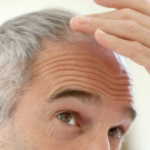All men are affected by hair loss as they get older, but for some blokes, balding can be more extensive, start earlier and be a real hit to their body image.
There are plenty of hair loss treatments on the market, but some are more snake oil than legitimate solutions.
Fortunately, finasteride is an effective treatment for hair loss. Here’s what you need to know about the medication, how it works and its side effects.
Firstly, what is finasteride?
Male pattern hair loss (also known as androgenic alopecia) is thought to be caused by a combination of family history and the effect of dihydrotestosterone (DHT) — a type of male hormone — on the hair follicle.
High levels of DHT can shrink your hair follicles and shorten the hair growth cycle, resulting in hair loss.
Finasteride is in a class of medications called 5-alpha reductase inhibitors. These work by suppressing an enzyme called 5-alpha-reductase, which converts part of your body’s testosterone into DHT.
This lowers the level of DHT in the scalp, and in men with mild to moderate balding (but not complete), Finasteride can reverse hair loss and prevent further hair loss.
How long does it take for finasteride to work?
A one-milligram dose of finasteride is taken once each day. It will not work faster or better if you take it more than once a day.
You’ll probably see results after daily use for three months or more. Finasteride will only slow hair loss while you’re taking it. If you stop taking it, you’ll probably lose any hair that grew over the next 12 months.
Is finasteride safe?
Research shows Finasteride to be a safe and effective drug, though side effects can cause problems for a small percentage of people who use it.
What are the side effects of finasteride?
All medications have side effects, some won’t affect everyone, and some are more severe than others. Side effects of finasteride include erectile dysfunction, low sex drive and reduced semen volume.
In clinical trials, these unwanted side effects went away when men stopped taking finasteride and in many men who continued the treatment.
However, some men report persistent sex drive and ejaculation problems after stopping the medication.
This does not necessarily mean that Finasteride is to blame, as many medical conditions and lifestyle factors can contribute to these issues.
You should see a doctor if you notice any lumps, pain or swelling in your chest area or discharge from your nipples — these may be signs of a serious condition such as breast cancer — or unusually low mood.
How to reduce side effects
Your sexual function is influenced by a variety of things, including medical conditions (like diabetes, depression and cardiovascular disease), your weight, whether you smoke and different medications.
It can help to keep on top of these things to ensure your sexual function is the best it can be.
What do we know about the long-term effects of finasteride?
There is a movement pushing for recognition of what they call post-finasteride syndrome (PFS), which is a term they use to describe ongoing sexual, neurological, physical and mental side effects in people who have used finasteride.
It’s a controversial topic that’s the subject of extensive litigation in the US, however, post-finasteride syndrome is not a recognised medical condition.
A literature review of adverse side effects associated with finasteride shows that persistent sexual side effects were only documented in low-quality studies in which the selection of participants was biased.
The only high-quality study of ongoing sexual side effects showed that these were more frequent in the placebo than in the treatment group, implying that the effects were not necessarily related to the treatment.
Oral versus topical finasteride
You can also use finasteride topically, which is when you apply it to the skin daily. Its effect is similar to oral finasteride but with reduced impact on the whole body, meaning it’s less likely you’ll experience sexual function side effects.
It’s important to note that finasteride is unsafe for women who are pregnant or trying to get pregnant.
If you are applying topical finasteride, you should avoid sharing a pillow with them and take precautions to limit their exposure elsewhere.
Women who are pregnant or may be pregnant should not handle crushed or broken tablets or handle tablets with wet hands.
Finasteride versus Minoxidil
Minoxidil (which also goes by its brand name Rogaine) is another male hair loss treatment. It’s applied to the scalp and is thought to increase hair growth by increasing blood flow around the follicles and moving your hair follicles into a phase of active growth quicker.
Like Finasteride, it only works as long as you’re using it. It’s effective, but a trial suggests it’s not as effective as finasteride.
Finasteride and minoxidil can also be used together and can be more effective than using one or the other.
How can you get finasteride in Australia?
You need a prescription to get finasteride in Australia, so chat to your doctor.
What can I use instead of finasteride?
If you want to treat hair loss, but you’re not keen on finasteride, effective finasteride alternatives include minoxidil and hair transplants.
Hair transplantation involves taking tiny plugs of hair from areas where it continues to grow and inserting them in bald areas.
Multiple transplant sessions are usually needed, and this can be expensive. However, results are usually good and are permanent.
Platelet-Rich Plasma (PRP) is often suggested as a treatment for male hair loss, but there is no strong evidence that it is effective.











